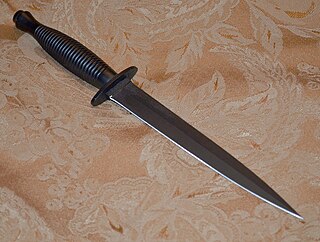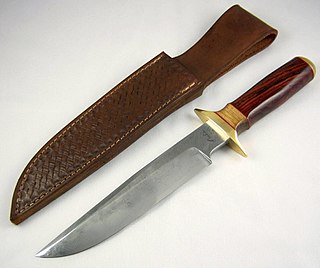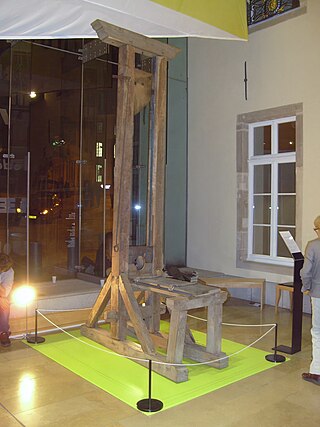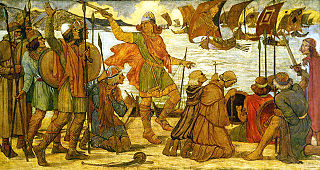A Ngulu is an execution sword used by the Bantu peoples (including the Ngombe, Doko, Ngala, etc.) of the Congo Basin.
Contents


A Ngulu is an execution sword used by the Bantu peoples (including the Ngombe, Doko, Ngala, etc.) of the Congo Basin.


It resembles the Khopesh, the sickle-sword of ancient Egypt, except that it has a much more massive blade, made of iron, with a non-cutting back and a semi-circular concavity. The handle, often surrounded by metal wire, ended with two large wooden buttons and a smaller one. It could be one or two blades and was used for capital executions by beheading (the condemned was kept seated, head extended and attached to a branch).: [1] This design was selected for cult and execution knives. A knife was created which symbolized the inexorableness on the judgment and execution. This execution knife became a symbol of power and, in a few variations became a ceremonial knife for tribal chieftains. At executions, the condemned man was tied to the ground with ropes and poles. His head was fastened with leather straps to a bent tree branch. In this way it was ensured that the man's neck would remain stretched. After the decapitation, the head would be automatically catapulted far away.
The Ngulu beheading was forbidden by the Belgians during the Free State of Congo period (1885-1908). The weapon, deprived of its function, took an even stronger symbolic and ceremonial value. From the 20th century, the Ngulu was worn during the ritual dance known as Likbeti, at the end of which the weapon was used to decapitate a goat whose flesh was then consumed by the whole tribe. [2]

A dagger is a fighting knife with a very sharp point and usually one or two sharp edges, typically designed or capable of being used as a cutting or thrusting weapon. Daggers have been used throughout human history for close combat confrontations, and many cultures have used adorned daggers in ritual and ceremonial contexts. The distinctive shape and historic usage of the dagger have made it iconic and symbolic. A dagger in the modern sense is a weapon designed for close-proximity combat or self-defense; due to its use in historic weapon assemblages, it has associations with assassination and murders. Double-edged knives, however, play different sorts of roles in different social contexts.

A knife is a tool or weapon with a cutting edge or blade, usually attached to a handle or hilt. One of the earliest tools used by humanity, knives appeared at least 2.5 million years ago, as evidenced by the Oldowan tools. Originally made of wood, bone, and stone, over the centuries, in step with improvements in both metallurgy and manufacturing, knife blades have been made from copper, bronze, iron, steel, ceramic, and titanium. Most modern knives have either fixed or folding blades; blade patterns and styles vary by maker and country of origin.

A guillotine is an apparatus designed for efficiently carrying out executions by beheading. The device consists of a tall, upright frame with a weighted and angled blade suspended at the top. The condemned person is secured with a pillory at the bottom of the frame, holding the position of the neck directly below the blade. The blade is then released, swiftly and forcefully decapitating the victim with a single, clean pass; the head falls into a basket or other receptacle below.

Decapitation is the total separation of the head from the body. Such an injury is invariably fatal to humans and most other animals, since it deprives the brain of oxygenated blood by way of severing through the jugular vein and common carotid artery, while all other organs are deprived of the involuntary functions that are needed for the body to function. The term beheading refers to the act of deliberately decapitating a person, either as a means of murder or as an execution; it may be performed with an axe, sword, or knife, or by mechanical means such as a guillotine. An executioner who carries out executions by beheading is sometimes called a headsman. Accidental decapitation can be the result of an explosion, a car or industrial accident, improperly administered execution by hanging or other violent injury. The national laws of Saudi Arabia and Yemen permit beheading. Under Sharia, which exclusively applies to Muslims, beheading is also a legal punishment in Zamfara State, Nigeria. In practice, Saudi Arabia is the only country that continues to behead its offenders regularly as a punishment for capital crimes. Cases of decapitation by suicidal hanging, suicide by train decapitation and by guillotine are known.
This is a list of types of swords.

The kukri or khukuri is a type of knife or short sword with a distinct recurve in its blade that originated in the Indian subcontinent. It serves multiple purposes as a melee weapon and also as a regular cutting tool throughout most of South Asia. The kukri, khukri, and kukkri spellings are of Indian English origin.

A tantō is a traditionally made Japanese knife that were worn by the samurai class of feudal Japan. The tantō dates to the Heian period, when it was mainly used as a weapon but evolved in design over the years to become more ornate. Tantō were used in traditional martial arts and in the seppuku suicide ritual. The term has seen a resurgence in the West since the 1980s as referring to a point style of modern tactical knives, designed for piercing or stabbing, though the style isn't present on any traditional tantō.

A blade is the sharp, cutting portion of a tool, weapon, or machine, specifically designed to puncture, chop, slice, or scrape surfaces or materials. Blades are typically made from materials that are harder than those they are intended to cut. This includes early examples made from flaked stones like flint or obsidian, evolving through the ages into metal forms like copper, bronze, and iron, and culminating in modern versions made from steel or ceramics. Serving as one of humanity's oldest tools, blades continue to have wide-ranging applications, including in combat, cooking, and various other everyday and specialized tasks.

A Bowie knife is a pattern of fixed-blade fighting knives created by Rezin Bowie in the early 19th century for his brother James Bowie, who had become famous for his use of a large knife at a duel known as the Sandbar Fight.

Knowledge about military technology of the Viking Age is based on relatively sparse archaeological finds, pictorial representations, and to some extent on the accounts in the Norse sagas and laws recorded in the 12th–14th centuries.

The butterfly sword is a short dao, or single-edged sword, originally from southern China, though it has also seen use in the north. It is thought that butterfly swords date from the early 19th century. Several English language accounts from the 1840s describe local militia in Guangdong being trained in the "double swords", short swords with a hook extending from the guard, and fitting into a single scabbard.

The kirpan is a blade that Khalsa Sikhs are required to wear as part of their religious uniform, as prescribed by the Sikh Code of Conduct. Traditionally, the kirpan was a full-sized talwar sword around 76 cm in length; however, British colonial policies and laws introduced in the 19th century reduced the length of the blade, and in the modern day, the kirpan is typically manifested as a dagger or knife. According to the Sikh Code of Conduct, "The length of the sword to be worn is not prescribed". It is part of a religious commandment given by Guru Gobind Singh in 1699, founding the Khalsa order and introducing the five articles of faith which must be worn at all times.

Bladesmithing is the art of making knives, swords, daggers and other blades using a forge, hammer, anvil, and other smithing tools. Bladesmiths employ a variety of metalworking techniques similar to those used by blacksmiths, as well as woodworking for knife and sword handles, and often leatherworking for sheaths. Bladesmithing is an art that is thousands of years old and found in cultures as diverse as China, Japan, India, Germany, Korea, the Middle East, Spain and the British Isles. As with any art shrouded in history, there are myths and misconceptions about the process. While traditionally bladesmithing referred to the manufacture of any blade by any means, the majority of contemporary craftsmen referred to as bladesmiths are those who primarily manufacture blades by means of using a forge to shape the blade as opposed to knifemakers who form blades by use of the stock removal method, although there is some overlap between both crafts.
Ngulu may refer to:
A knife fight is a violent physical confrontation between two or more combatants in which one or more participants are armed with a knife. A knife fight is defined by the presence of a knife as a weapon and the violent intent of the combatants to kill or incapacitate each other; the participants may be completely untrained, self-taught, or trained in one or more formal or informal systems of knife fighting. Knife fights may involve the use of any type of knife, though certain knives, termed fighting knives, are purposely designed for such confrontations – the dagger being just one example.

The harpē (ἅρπη) is a type of sword- or sickle-like weapon mentioned in Greek and Roman sources, and almost always in mythological contexts.
Historically, Chinese swords are classified into two types, the jian and the dao. A Jian is a straight, double-edged sword mainly used for stabbing, and has been commonly translated into the English language as a longsword; while a dao is a single-edged sword mainly used for cutting, and has been translated as a saber or a "knife".

An executioner's sword is a sword designed specifically for decapitation of condemned criminals. These swords were intended for two-handed use, but were lacking a point, so that their overall blade length was typically that of a single-handed sword. The quillons were quite short, and mainly straight, and the pommel was often pear-shaped or faceted.
Knife legislation is defined as the body of statutory law or case law promulgated or enacted by a government or other governing jurisdiction that prohibits, criminalizes, or restricts the otherwise legal manufacture, importation, sale, transfer, possession, transport, or use of knives.

Native American weaponry was used by Native American warriors to hunt and to do battle with other Native American tribes and Europeans.